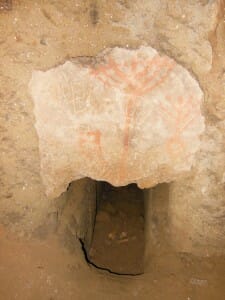
In order to continue our pursuit of Roman Jewish history, we took a step back in time by visiting the Jewish catacombs in Rome. I had read on Micaela Pavoncello’s website about this unique tour that focused on the late antiquity period. Not too many people venture off the beaten track in search of underground burial places for Roman Jews.
Dozens of catacombs have been unearthed within Rome’s metro area, but only a handful housed Jewish remains. Only one of the six is currently available for limited tours. A hefty fee of 275 euros discourages most from taking part in this once in a lifetime adventure.
Our taxi driver shrugged his shoulders when we handed over Micaela’s Italian directions. He needed to call Micaela for clarification. Luckily, he was an honorable driver.The driver turned off the meter once he realized our destination would be difficult to locate. We drove around for at least another 10 minutes before we stopped.
At the designated gate, we were met by an elderly Italian caretaker who did not speak English. Our courteous driver made certain we were at the correct place before he drove away. We waited in an open field that included a wide variety of vegetation.
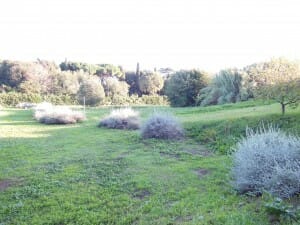
Sara, our guide, arrived soon thereafter. We walked toward the other end of the field toward a structure that appeared submerged. Before entering the locked and partially hidden doorway, the caretaker handed us a form. Sara asked us to sign the liability waiver written in Italian. Then, he handed us high intensity flashlights and our adventure began.
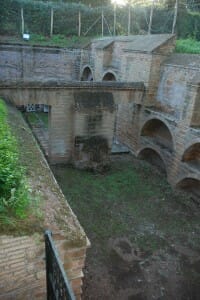
In ancient times, skylights and lanterns were used to illuminate the dark pathway. Today, the artificial light was needed since the lanterns had been removed and the skylights were partially obscured.
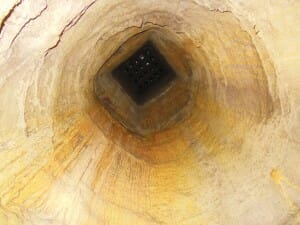
We followed Sara and the caretaker through the maze-like tunnels. The stale air had a musty odor. On both sides of the tunnel troughs were cut into the soft volcanic rock. These burial places for Jews and pagans were used from the 3rd to the 5th centuries. Grave robbers and the expeditions in the 19th century removed all of the artifacts and almost all of the remains.
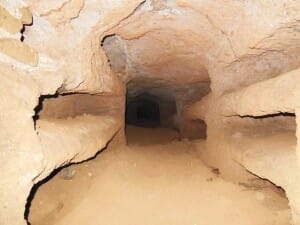
We passed by several small corridors that included a multitude of former graves.
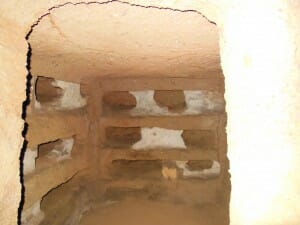
Sara periodically deciphered the Latin and Greek plaques that marked the names of the deceased. Only a few bones remained. In some places, the underground structure had been reinforced with concrete bricks.
Most of the signs were simply engraved with letters and occasionally a simple picture or two. Sara told us this picture represented a klaf’, the parchment of the Torah. It is believed that this was the grave of a sofer. The scribe of the community
.
This one was in red.
Jewish symbols in a few places confirmed a Jewish presence.
Some signs had more than one graphic. Common pictures included- lulavs, etrogs, pomegranates, and menorahs.
Many were cracked. Some had missing pieces. In a few instances, the writing and pictures had been worn away and were hard to decipher.
The highlight of the tour was a series of colorful rooms. The decorations were more detailed and included wildlife and images of people.
We were in awe as we snapped one picture after another. Sara told us to record as much as we could because the signage would continue to deteriorate each year.
The penetration of moisture will eventually cause the inscriptions to become unreadable. Calcium deposits were forming crystals at various points along the way.
The inscriptions and the pictures have led historians to believe that some of these tunnels housed the remains of pagans. Sadly, modern graffiti etched into the colorful designs desecrated this incredible site.
With only one Jewish catacomb open to the public, Ira and I were fortunate to be able to arrange a private tour to coincide with our visit to Rome. In retrospect, I wish that I had tape recorded Sara’s explanations. It was not possible to take notes or remember all of her detailed explanations.
If you are visiting Rome and are interested in exploring the underground world of Jewish catacombs, contact Micaela Pavoncello for your opportunity to step back in time.
For additional information regarding catacombs visit the International Catacomb Society and Jessica Dello Russo site. Jessica has written extensively on the Jewish catacombs in Rome.
Related Blogs
Looking for Greek Jewish History
Hamat Teverya National Park- An Historical Gem in the Galilee
Bet She’arim- Important Necropolis from Talmudic Times
A Slice of Rome- The Jewish Experience
Taormina- A Lovely Place With a Troubling History
Baking Challah Per Celebrity Cruises
Bio
Sandra Bornstein is the author of MAY THIS BE THE BEST YEAR OF YOUR LIFE. It is available on Amazon.
Sandra’s memoir highlights her living and teaching adventure in Bangalore, India. She is a licensed Colorado teacher who has taught K-12 students in the United States and abroad as well as college level courses. Sandra is married and has four adult sons.
The memoir was a finalist in the Travel category for the 2013 Next Generation Indie Book Awards, the 2013 International Book Awards, the 2013 National Indie Book Excellence Awards, 2013 USA Best Book Awards, and a Honorable Mention award in the Multicultural Non-Fiction category for the 2013 Global ebook Awards.

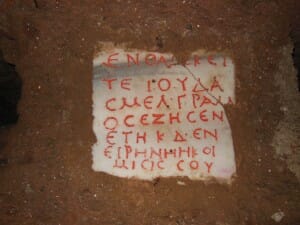
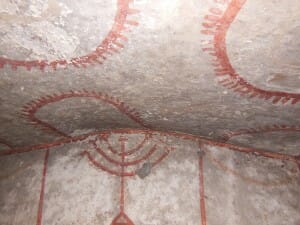
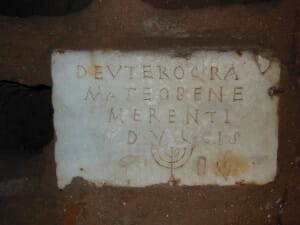
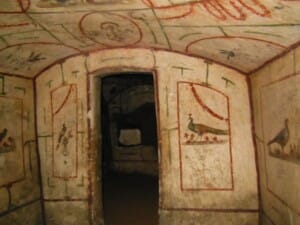
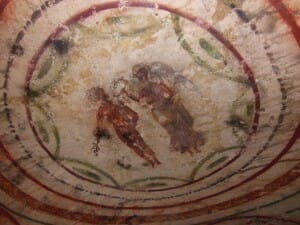
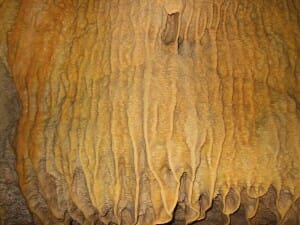
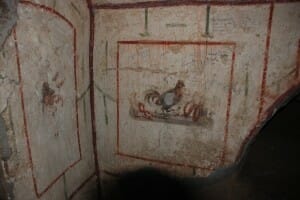
Aramaic epigraphy was “hard to decipher”, and easy to confuse with modern latin alphabet.
DEVTEROGRA / MATEOBENE / MERENTI / DVLGIS
ד רז ערס תגש ט
שף שבע שתדמ
יתפס רשמ
ניזלג ט
Can you provide more details? Which illustration are you describing? Can you provide an English translation for the Aramaic? Thanks.